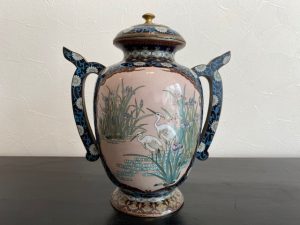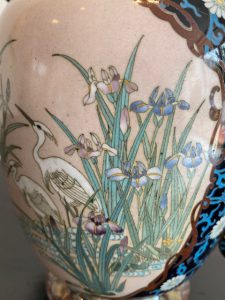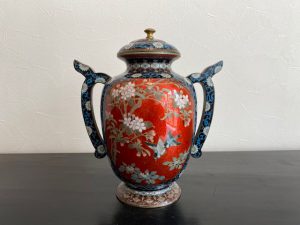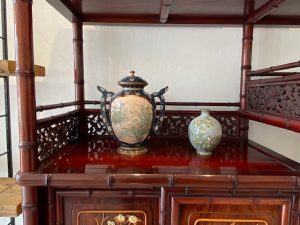クイズ この花なーんだ?(名古屋市千種区姫池通 古美術風光舎 名古屋店)
2021.06.07
皆さまこんにちは。スタッフMです。

本日のブログは、いつもと趣向を変えまして、クイズから参ります。
この壺に描かれているのは何という花でしょうか?
こちらの壺は、明治の初め頃にヨーロッパに輸出された七宝焼で、それが里帰りし、現在は風光舎名古屋店にございます。白鷺の傍の水辺に群生して咲いている、この花の名前をお答えください!

お花に詳しい方は一瞬でお分かりになりましたよね。尊敬します!でも、私は「あやめ?菖蒲(しょうぶ)?杜若(かきつばた)?」とわかりません。おそらくこの三つの花で迷われている方も多いのではないでしょうか。わからないことがあると調べてみないと気が済まない性分の私は、さっそく三つの花の違いを調べてみました。見分けるポイントは3つあるようです。
1つ目は、花びらの付け根の違いに注目します。あやめは網目状の模様、菖蒲は黄色い模様、杜若は白くスーっと筋が入っているのが特徴です。これでおおかた予想がつきましたね。しかし、念には念を、ということで、2つ目のポイントにも注目してみます。二つ目は、育つ場所の違いです。あやめだけは意外にも陸地で育つそうですが、杜若は水を好むので池や沼地という常に水のある場所で育つようです。では菖蒲はというと、あやめと杜若の中間地の水辺だそうです。水の流れに沿うように群生して咲く菖蒲をご覧になったことはありませんか。全国にも、有名な菖蒲園がございますよね。そんなわけで、黄色い模様で水辺に群生しているこの花の名前は、「菖蒲」だと思われます!すみません、クイズにしたのに、答えが私の推察でしかないということをお許しください。
ちなみに、ご近所で咲いているこれらを見分けようとしたら、咲く時期にも注目されるといいそうです。それが3つ目のポイントですが、咲く順番に言うと、杜若が5月中旬、あやめが5月中旬から下旬、菖蒲が6月から7月中旬です。杜若やあやめは、新緑が茂る、夏の気配が漂い始める頃の一瞬なのに対し、菖蒲は梅雨の雨の多い時期に1ヵ月くらい長く咲くのも特徴のようです。そのような菖蒲は日本人の美意識に合い、古くから愛されてきました。江戸時代から改良が重ねられ、花の色は白、桃、紫、青、黄など多数あるようです。また形の違いなどの組み合わせを含めると、今では5000種類くらいあるということです。
杜若も同じように古くから愛されてきました。在原業平が「から衣 きつつなれにし つましあれば はるばる来ぬる たびをしぞ思ふ」とそれぞれの句の頭文字をとると「かきつばた」にになるように詠んだ和歌はあまりにも有名です。すっきりとして上品な雰囲気のただよう杜若を、昔の歌人たちは愛する女性に例えて歌に詠みました。また日本画にもよく描かれました。特に有名な画で言えば、尾形光琳の『燕子花屏風』(国宝)ですよね。美術の教科書で日本人なら必ず見る絵画の一つです。私もいつかは本物を見に、根津美術館に行ってみたいと思っています。

日本には「いずれあやめか杜若」という言葉がありまして、どちらも優れていて優劣をつけがたく、選択に迷うことの例えとして使われています。このように、七宝焼の壺に描かれた花が「あやめか、菖蒲か、杜若か」はわからなかったけれども、この作品のとても美しいことや、すばらしく芸が細かく繊細であることはわかりました。それはずっと飽きずに見ていられるほどです。きっと、明治時代にヨーッパに輸出された時、同じようにようにヨーロッパの人たちも感じたことでしょう。何人の方の手に渡ったかも今となってはわかりませんが、大切に大切に扱われたからこそ、日本に里帰りできたのだと思います。様々な歴史を見つめ続けてきたこの七宝焼きの壺を、是非ご覧になりませんか。風光舎名古屋店で待っています。御機嫌よう。 (スタッフM)

Hello everyone. This is Staff M.
Today’s blog will start with a quiz, changing the taste from usual.
What kind of flower is drawn on this jar?
This jar is a cloisonne ware that was exported to Europe in the early Meiji era, and it has returned home and is now in the Fukosha Nagoya store. Please answer the name of this flower that is blooming in clusters on the waterside near the egret!
Those who are familiar with flowers can understand it in an instant. Respect to you! But I don’t understand “Ayame? Iris? Kakitsubata?” Perhaps many people are confused by these three flowers. I can’t help but find out what I don’t understand, so I immediately investigated the difference between the three flowers. There seem to be three points to distinguish.
The first is to pay attention to the difference in the base of the petals. The iris has a mesh-like pattern, the iris has a yellow pattern, and the iris has a white and smooth streak. This is a good idea. However, just in case, let’s pay attention to the second point. The second is the difference in where they grow up. It seems that only Ayame grows on land, but Kakitubata likes water, so she seems to grow in ponds and swamps where there is always water. Then, the iris is said to be the waterside between Ayame and Kakitubata. Have you ever seen irises blooming in clusters along the flow of water? There are also famous iris gardens all over the country. That’s why the name of this flower, which has a yellow pattern and grows on the water’s edge, seems to be “iris”! Excuse me, please forgive me for the quiz, but the answer is only my guess.
By the way, if you try to distinguish these blooming in your neighborhood, you should pay attention to the time when they bloom. That is the third point, but in the order of blooming, Kakitubata is in mid-May, Ayame is in mid-May to late May, and Iris is in June-Mid-July. Kakitubata and Ayame are in the moment when the fresh greenery grows and the signs of summer begin to drift, while the iris blooms for about a month longer during the rainy season. Such irises fit the Japanese aesthetic sense and have been loved for a long time. Improvements have been made since the Edo period, and it seems that there are many flower colors such as white, peach, purple, blue, and yellow. Including combinations such as differences in shape, there are now about 5,000 types.
Kakitubata has also been loved for a long time. Ariwara no Narihira wrote a waka poem that would be “Kakitsubata” when the acronym for each phrase was taken, saying, “If he’s dressed up, he’ll come all the way to him.” Is too famous. The clean and elegant atmosphere of Kakitubata was compared to a beloved woman by old poets. It was also often drawn in Japanese paintings. Speaking of a particularly famous painting, it is Ogata Korin’s “Irises Screen” (national treasure). It is one of the paintings that Japanese people always see in art textbooks. I would like to go to the Nezu Museum to see the real thing someday.
In Japan, there is the word “Ayame or Kakitubata”, both of which are superior and inferior, and are used as an analogy to wondering which choice to make. In this way, I did not know whether the flowers drawn on the cloisonne jar were “iris, iris, or moriwaka”, but I found that this work was very beautiful and that the art was wonderfully delicate. It’s so much that you can watch it all the time. I’m sure Europeans would have felt the same when it was exported to Yoppa in the Meiji era. I don’t know how many people have passed it now, but I think I was able to return to Japan because I was treated with great care. Why don’t you take a look at this cloisonne jar that has been staring at various histories? We are waiting at Fukosha Nagoya store. Good mood. (Staff M)
***********************
生活様式の変化とともに、大切なお品を整理されている方も多いことと思われます。
ここ風光舎では、古美術品や骨董品の他にも絵画や宝石、趣味のお品など様々なジャンルのものを買受しております。
お片付けをされていて、こういうものでもいいのかしらと迷われているものでも、どうぞお気軽にご相談下さいませ。
風光舎は、出張買取も強化しております。
愛知県内はもちろん、岐阜県・三重県その他の県へも出張いたします。
どんなにご近所の方でもお伺いできますので、まずはお電話お待ちしております。
愛知県名古屋市千種区・骨董 買取
『古美術 風光舎 名古屋店』
TEL 052(734)8444
10:00-17:00 OPEN
It seems that many people are organizing important items as their lifestyle changes.
Here at Fukosha, in addition to antiques and antiques, we also purchase paintings, jewelry, hobby items, and other genres.
Please feel free to contact us even if you have been tidied up and are wondering if this kind of thing is okay.
Fukosha is also strengthening business trip purchases.
We will make business trips not only to Aichi prefecture but also to Gifu prefecture, Mie prefecture and other prefectures.
No matter how close you are, we are looking forward to your call.
Chikusa Ward, Nagoya City, Aichi Prefecture, antique purchase
“Ancient Art Fukosha Nagoya Store”
TEL 052 (734) 8444
10: 00-17: 00 OPEN

